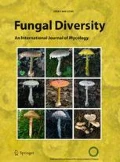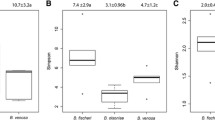Abstract
Insect-induced galls are abnormal plant growths that can provide food and shelter to their inhabitants, resulting in stressed plant tissue that may alter the conditions for the colonization or proliferation of endophytic fungi. We investigated the effect gall formation has on fungal endophyte communities and diversity. Using three closely-related gall-forming aphid species that specialize on poplars, we characterized fungal endophyte diversity in galls and surrounding petiole and leaf lamina tissue. A total of 516 fungal endophyte samples were isolated from 272 tissue samples (32 leaves, 31 petioles, and 209 galls), resulting in 23 distinct morphotypes. Despite sharing a common host plant and often forming spatially contiguous galls, the endophyte profiles within the galls of each aphid species were distinct, not only from the galls of the other species, but also from surrounding plant tissue. These results suggest that insect galls can affect the composition of fungal endophyte species in plant tissues, by altering either the colonization or proliferation of their endophytic mycobiota. Likewise, fungal endophytes may be important in the ecology and evolution of insect galls.
Similar content being viewed by others
References
Abbot P, Withgott JH (2004) Phylogenetic and molecular evidence for allochronic speciation in gall-forming aphids (Pemphigus). Evolution 58:539–553
Albrectsen BR, Björkén L, Varad A, Hagner Å, Wedin M, Karlsson J, Jansson S (2010) Endophytic fungi in European aspen (Populus tremula) leaves- diversity, detection, and a suggested correlation with herbivory resistance. Fun Div 41:17–28. doi:10.1007/s13225-009-0011-y
Andret-Link P, Fuchs M (2005) Transmission specificity of plant viruses by vectors. J Plant Pathol 87(3):153–165
Bailey JK, Whitham TG (2003) Interactions among elk, aspen, galling sawflies and insectivorous birds. Oikos 101(1):127–134. doi:10.1034/j.1600-0706.2003.12185.x
Bailey JK, Deckert R, Schweitzer JA, Rehill BJ, Lindroth RL, Gehring C, Whitham TG (2005) Host plant genetics affect hidden ecological players: links among Populus, condensed tannins, and fungal endophyte infection. Can J Bot 83:356–361. doi:10.1139/B05-008
Bellemain E, Carlsen T, Brochmann C, Coissac E, Taberlet P, Kauserud H (2010) ITS as an environmental DNA barcode for fungi: an in silico approach reveals potential PCR biases. BMC Microbiol 10:189. doi:10.1186/1471-2180-10-189
Blackman RL, Eastop VF (1994) Aphids on the world’s trees: an identification and information guide. Cab International, Wallingford, pp 801–812
Botella L, Diez JJ (2011) Phylogenic diversity of fungal endophytes in Spanish stands of Pinus halepensis. Fun Div 47:9–18. doi:10.1007/s13225-010-0061-1
Butin H (1992) Effect of endophytic fungi from oak (Quercus robur L.) on mortality of leaf inhabiting gall insects. Eur J For Pathol 22:237–246
Carroll G (1995) Forest endophytes- pattern and process. Can J Bot 73:S1316–S1324
Carroll GC, Carroll FE (1978) Studies on the incidence of coniferous needle endophytes in the Pacific Northwest. Can J Bot 56(24):3034–3043
Clay K (1988) Fungal endophytes of grasses- a defensive mutualism between plants and fungi. Ecology 69:10–16. doi:10.2307/1943155
Clay K, Schardl C (2002) Evolutionary origins and ecological consequences of endophyte symbiosis with grasses. Am Nat 160:99–127. doi:10.1086/342161
Deckert RJ, Mellville LH, Peterson RL (2001) Structural features of a Lophodermium endophyte during the cryptic life-cycle phase in the foliage of Pinus stobus. Mycol Res 105:991–997
Doty SL, Oakley B, Xin G, Kang JW, Singleton G, Khan Z, Vajzovic A, Staley JT (2009) Diazotrophic endophytes of native black cottonwood and willow. Symbiosis 47:23–33
Faeth SH, Hammon KE (1997) Fungal endophytes in oak trees: long-term patterns of abundance and associations with leafminers. Ecology 78(3):810–819. doi:10.1890/0012-9658(1997)078[0810:FEIOTL]2.0.CO;2
Hartley SE, Gange AC (2009) Impacts of plant symbiotic fungi on insect herbivores: mutualism in a multitrophic context. Ann Rev Entomol 54:323–342. doi:10.1146/annurev.ento.54.110807.090614
Hata K, Futai K (1994) Endophytic fungi associated with healthy pine needles and needles infested by the pine needle gall midge, Thecodiplosis japonensis. Can J Bot 73:384–390
Hoffman MT, Arnold AE (2010) Diverse bacteria inhabit living hyphae of phylogenetically diverse fungal endophytes. Appl Environ Microbiol 76(12):4063–4075. doi:10.1128/AEM.02928-09
Koukol O, Kolarik M, Kolarova Z, Baldrian P (2012) Diversity of foliar endophytes in wind-fallen Picea abies trees. Fun Div 54:69–77. doi:10.1007/s13225-011-0112-2
Kumar DSS, Hyde KD (2004) Biodiversity and tissue-recurrence of endophytic fungi in Tripterygium wilfordii. Fun Div 17:69–90
Larson KC, Whitham TG (1997) Competition between gall aphids and natural plant sinks: plant architecture affects resistance to galling. Oecologia 109:575–582. doi:10.1007/s004420050119
Lasota JA, Waldvogel MG, Shetlar DJ (1983) Fungus found in galls of Adelges abietis (L) (Homoptera, Adelgidae)- identification, within-tree distribution, and possible impact on insect survival. Environ Entomol 12:245–246
Li HY, Shen M, Zhou ZP, Li T, Wei Y, Lin L (2012) Diversity and cold adaptation of endophytic fungi from five dominant species collected from the Baima Snow Mountain, Southwest China. Fun Div 54:79–86. doi:10.1007/s13225-012-0153-1
Martín-García J, Espiga E, Pando V, Diez JJ (2011) Factors influencing endophytic communities in poplar plantations. Silva Fenn 45(2):169–180
Martinsen GD, Floate KD, Waltz AM, Wimp GM, Whitham TG (2000) Positive interactions between leafrollers and other arthropods enhance biodiversity on hybrid cottonwoods. Oecologia 123:82–89. doi:10.1007/s004420050992
Mishra A, Gond SK, Kumar A, Sharma VK, Verma SK, Kharwar RN, Sieber TN (2012) Season and tissue type affect fungal endophyte communities of the Indian medicinal plant Tinospora cordifolia more strongly than geographic location. Microb Ecol 64:388–398. doi:10.1007/s00248-012-0029-7
Nault LR (1997) Arthropod transmission of plant viruses: a new synthesis. Ann Entomol Soc Am 90(5):521–541
Nilsson RH, Kristiansson E, Ryberg M, Hallenberg N, Larsson KH (2008) Intraspecific ITS variability in the kingdom fungi as expressed in the international sequence databases and its implications for molecular species identification. Evol Bioinforma 4:193–201
Pehl L, Butin H (1994) Endophytische pilze in blattern von laubbaumen und ihre beziehungen zu blattgallen (Zoocecidien). Mitt Biol Bundesanst Land- Forstwirtsch Berl-Dahl 297:1–56
Petrini O, Stone J, Carroll FE (1982) Endophytic fungi in evergreen shrubs in western Oregon- a preliminary study. Can J Bot 60(6):789–796
Porras-Alfaro A, Bayman P (2011) Hidden fungi, emergent properties: endophytes and microbiomes. Annu Rev Phytopathol 49:291–315. doi:10.1146/annurev-phyto-080508-081831
Preszler RW, Gaylord ES, Boecklen WJ (1996) Reduced parasitism of a leaf-mining moth on trees with high infection frequencies of an endophytic fungus. Oecologia 108:159–166. doi:10.1007/BF00333227
Purahong W, Hyde K (2011) Effects of fungal endophytes on grass and non-grass litter decomposition rates. Fun Div 47:1–7. doi:10.1007/s13225-010-0083-8
Raman A (2011) Morphogenesis of insect-induced plant galls: facts and questions. Flora 206(6):517–533. doi:10.1016/j.flora.2010.08.004
Raman A (2012) Gall induction by hemipteroid insects. J Plant Interact 7(1):29–44. doi:10.1080/17429145.2011.630847
Raman A, Wheatley W, Popay A (2012) Endophytic fungus-vascular plant-insect interactions. Environ Entomol 41(3):433–447. doi:10.1603/EN11317
Rodriguez RJ, White JF, Arnold AE, Redman RS (2009) Fungal endophytes: diversity and functional roles. New Phytol 182(2):314–330. doi:10.1111/j.1469-8137.2009.02773.x
Saikkonen K, Faeth SH, Helander M, Sullivan TJ (1998) Fungal endophytes: a continuum of interactions with host plants. Annu Rev Ecol Syst 29:319–343. doi:10.1146/annurev.ecolsys.29.1.319
Saikkonen K, Saari S, Helander M (2010) Defensive mutualism between plants and endophytic fungi? Fun Div 41:101–113. doi:10.1007/s13225-010-0023-7
Santamaria O, Diez JJ (2005) Fungi in leaves, twigs and stem bark of Populus tremula from northern Spain. For Pathol 35(2):95–104. doi:10.1111/j.1439-0329.2004.00389.x
Schonrogge K, Harper LJ, Lichtenstein CP (2000) The protein content of tissues in cynipid galls (Hymenoptera: Cynipidae): similarities between cynipid galls and seeds. Plant Cell Environ 23:215–222. doi:10.1046/j.1365-3040.2000.00543.x
Shorthouse JD, Rohfritsch O (1992) Biology of insect-induced galls. Oxford University Press, Oxford
Sieber TN (2007) Endophytic fungi in forest trees: are they mutualist? Fun Biol Rev 21:75–89. doi:10.1016/j.fbr.2007.05.004
Sokal RR, Rohlf FJ (1995) Biometry: the principles and practice of statistics in biological research, 3rd edn. W.H. Freeman, New York
Stone GN, Schonrogge K (2003) The adaptive significance of insect gall morphology. Trends Ecol Evol 18:512–522. doi:10.1016/S0169-5347(03)00247-7
Stone JK, Polishook JD, White JF (2004) Endophytic fungi. In: Biodiversity of fungi. Elsevier Academic Press, Burlington, VT, pp 241–270
Su YY, Guo LD, Hyde KD (2010) Response of endophytic fungi of Stipa grandis to experimental plant function group removal in Inner Mongolia steppe, China. Fun Div 43(1):93–101. doi:10.1007/s13225-010-0040-6
Suryanarayanan TS, Vijaykrishna D (2001) Fungal endophytes of aerial roots of Ficus benghalensis. Fun Div 155–161
Waltz AM, Whitham TG (1997) Plant development affects arthropod communities: opposing impacts of species removal. Ecology 78(7):2133–2144. doi:10.1890/0012-9658(1997)078[2133:PDAACO]2.0.CO;2
Wei YK, Gao YB, Zhang X, Su D, Wang YH, Xu H, Lin F, Ren AZ, Chen L, Nie LY (2007) Distribution and diversity of Epichloe/Neotyphodium fungal endophytes from different populations of Achnatherum sibiricum (Poaceae) in the Inner Mongolia Steepe, China. Fun Div 24:329–0345
Wilson D (1995) Fungal endophytes which invade insect galls: insect pathogens, benign saprophytes, or fungal inquilines? Oecologia 103:255–260. doi:10.1007/BF00329088
Wilson D, Carroll GC (1997) Avoidance of high-endophyte space by gall-forming insects. Ecology 78:2153–2163. doi:10.1890/0012-9658(1997)078[2153:AOHESB]2.0.CO;2
Wilson D, Faeth SH (2001) Do fungal endophytes result in selection for leafminer ovipositional preference? Ecology 82:1097–1111
Yuan ZL, Zhang CL, Lin FC, Kubicek CP (2010) Identity, diversity, and molecular phylogeny of the endophytic mycobiota in the roots of rare wild rice (Oryza granulate) from a nature reserve in Yunnan, China. Appl Environ Microbiol 76(5):1642–1652. doi:10.1128/AEM.01911-09
Acknowledgments
This work was supported by a National Science Foundation grant #IOS-1147033 and a Vanderbilt University Central Discovery Grant awarded to PA. We are grateful to members of the Rokas lab, specifically John Gibbons and Jason Slot, for their help with the fungal cultures and identification. We would also like to acknowledge Hayden Hill for his help upkeeping the fungal cultures and Cassidy Cobbs for her feedback on the experimental design and data analysis. Lastly, we cannot forget to thank the reviewers of this paper, who provided us with helpful feedback and suggestions.
Author information
Authors and Affiliations
Corresponding author
Rights and permissions
About this article
Cite this article
Lawson, S.P., Christian, N. & Abbot, P. Comparative analysis of the biodiversity of fungal endophytes in insect-induced galls and surrounding foliar tissue. Fungal Diversity 66, 89–97 (2014). https://doi.org/10.1007/s13225-013-0268-z
Received:
Accepted:
Published:
Issue Date:
DOI: https://doi.org/10.1007/s13225-013-0268-z



